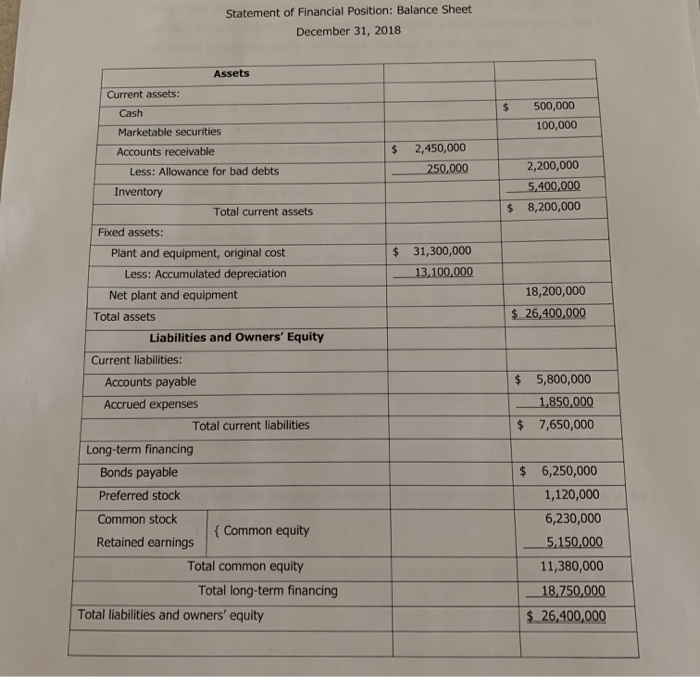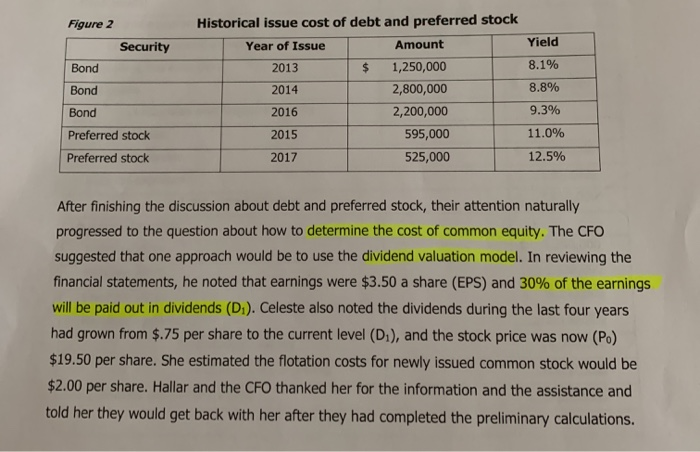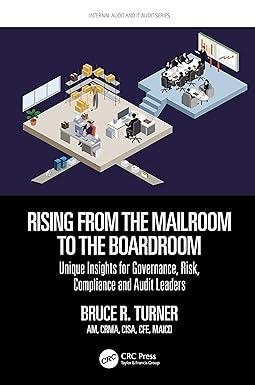Case Questions (show all of your work) 1. Determine the appropriate weights for each component in the capital structure: Use the amount of retained earnings (as part of common equity) provided. The percentage composition (weights) in the capital structure for bonds, preferred stock, and common equity should be based on the current capital structure long-term financing section as shown in Figure 1 (indicated as $18.75 million). Common equity will remain at the current weight throughout the case, and the combined tax rate is 25%. 2. Determine the cost for each component in the capital structure: (Record the values to 2 decimal places when calculating percentages). a. Before tax and after-tax cost of debt b. Cost of preferred stock C. Cost of equity. Use your calculator to solve for the growth rate (I/YR key), to use in the formula: rs = D/P+ 9 3. Given your results from questions 1 and 2 above, calculate the weighted average cost of capital (WACC). 4. Next, assume that new common stock will be used in the capital structure (you will obtain new common stock and incur flotation costs in the transaction). Also assume all the weights Statement of Financial Position: Balance Sheet December 31, 2018 500,000 100,000 $ 2,450,000 250.000 2,200,000 5,400,000 8,200,000 $ $ 31,300,000 13,100,000 18,200,000 $ 26,400,000 Assets Current assets: Cash Marketable securities Accounts receivable Less: Allowance for bad debts Inventory Total current assets Fixed assets: Plant and equipment, original cost Less: Accumulated depreciation Net plant and equipment Total assets Liabilities and Owners' Equity Current liabilities: Accounts payable Accrued expenses Total current liabilities Long-term financing Bonds payable Preferred stock Common stock { Common equity Retained earnings Total common equity Total long-term financing Total liabilities and owners' equity $ 5,800,000 1,850,000 7,650,000 $ $ 6,250,000 1,120,000 6,230,000 5,150,000 11,380,000 18,750,000 $ 26,400,000 Yield 8.1% Figure 2 Security Bond Bond Bond Preferred stock Preferred stock Historical issue cost of debt and preferred stock Year of Issue Amount 2013 $ 1,250,000 2014 2,800,000 2016 2,200,000 2015 595,000 2017 525,000 8.8% 9.3% 11.0% 12.5% After finishing the discussion about debt and preferred stock, their attention naturally progressed to the question about how to determine the cost of common equity. The CFO suggested that one approach would be to use the dividend valuation model. In reviewing the financial statements, he noted that earnings were $3.50 a share (EPS) and 30% of the earnings will be paid out in dividends (D). Celeste also noted the dividends during the last four years had grown from $.75 per share to the current level (D), and the stock price was now (Po) $19.50 per share. She estimated the flotation costs for newly issued common stock would be $2.00 per share. Hallar and the CFO thanked her for the information and the assistance and told her they would get back with her after they had completed the preliminary calculations. Case Questions (show all of your work) 1. Determine the appropriate weights for each component in the capital structure: Use the amount of retained earnings (as part of common equity) provided. The percentage composition (weights) in the capital structure for bonds, preferred stock, and common equity should be based on the current capital structure long-term financing section as shown in Figure 1 (indicated as $18.75 million). Common equity will remain at the current weight throughout the case, and the combined tax rate is 25%. 2. Determine the cost for each component in the capital structure: (Record the values to 2 decimal places when calculating percentages). a. Before tax and after-tax cost of debt b. Cost of preferred stock C. Cost of equity. Use your calculator to solve for the growth rate (I/YR key), to use in the formula: rs = D/P+ 9 3. Given your results from questions 1 and 2 above, calculate the weighted average cost of capital (WACC). 4. Next, assume that new common stock will be used in the capital structure (you will obtain new common stock and incur flotation costs in the transaction). Also assume all the weights Statement of Financial Position: Balance Sheet December 31, 2018 500,000 100,000 $ 2,450,000 250.000 2,200,000 5,400,000 8,200,000 $ $ 31,300,000 13,100,000 18,200,000 $ 26,400,000 Assets Current assets: Cash Marketable securities Accounts receivable Less: Allowance for bad debts Inventory Total current assets Fixed assets: Plant and equipment, original cost Less: Accumulated depreciation Net plant and equipment Total assets Liabilities and Owners' Equity Current liabilities: Accounts payable Accrued expenses Total current liabilities Long-term financing Bonds payable Preferred stock Common stock { Common equity Retained earnings Total common equity Total long-term financing Total liabilities and owners' equity $ 5,800,000 1,850,000 7,650,000 $ $ 6,250,000 1,120,000 6,230,000 5,150,000 11,380,000 18,750,000 $ 26,400,000 Yield 8.1% Figure 2 Security Bond Bond Bond Preferred stock Preferred stock Historical issue cost of debt and preferred stock Year of Issue Amount 2013 $ 1,250,000 2014 2,800,000 2016 2,200,000 2015 595,000 2017 525,000 8.8% 9.3% 11.0% 12.5% After finishing the discussion about debt and preferred stock, their attention naturally progressed to the question about how to determine the cost of common equity. The CFO suggested that one approach would be to use the dividend valuation model. In reviewing the financial statements, he noted that earnings were $3.50 a share (EPS) and 30% of the earnings will be paid out in dividends (D). Celeste also noted the dividends during the last four years had grown from $.75 per share to the current level (D), and the stock price was now (Po) $19.50 per share. She estimated the flotation costs for newly issued common stock would be $2.00 per share. Hallar and the CFO thanked her for the information and the assistance and told her they would get back with her after they had completed the preliminary calculations









